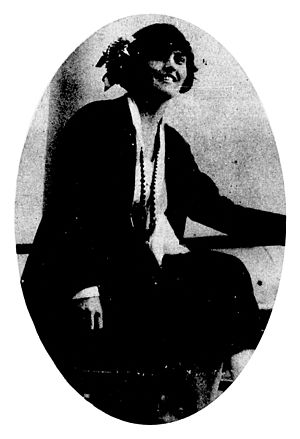Elsie Mackay facts for kids
Quick facts for kids
Elsie Mackay
|
|
|---|---|

Mackay in 1922
|
|
| Born | 1893 Simla, India
|
| Died | 13 March 1928 (aged 35) Lost in the Atlantic Ocean
|
| Nationality | British |
| Other names | Poppy Wyndham |
| Occupation | Actress, Interior designer, Aviator |
| Spouse(s) | |
Lady Elsie Mackay (born August 21, 1893 – died March 13, 1928) was a brave British woman who did many interesting things. She was an actress, a jockey, and an interior decorator. She was also a very early aviator, meaning she flew airplanes. Elsie sadly disappeared while trying to fly across the Atlantic Ocean with a pilot named Walter G. R. Hinchliffe. Her stage name, which is the name she used for acting, was Poppy Wyndham.
Contents
About Elsie Mackay
Elsie Mackay was born on August 21, 1893, in Simla, India. Her father, James Mackay, 1st Earl of Inchcape, was an important British leader in India. He later became the head of a big shipping company called the Peninsular and Oriental Steam Navigation Company (P&O).
Elsie's family was reportedly upset when she married an actor named Dennis Wyndham on May 23, 1917. She acted in plays and movies from 1919 to 1921, using the name Poppy Wyndham. Her marriage was later ended in 1922.
As Poppy Wyndham, Elsie was also the first woman jockey in England. A jockey is someone who rides horses in races. She was very good at it, winning many races. People often bet a lot of money on her because she was so successful.
Elsie's Movies
As Poppy Wyndham, Elsie appeared in several films:
- A Great Coup (1919) where she played Kate Hampton
- Snow in the Desert (1919)
- Many a Slip (1919) as The Girl
- A Dead Certainty (1920) where she played Pat Stone
- The Town of Crooked Ways (1920) as Queenie Clay
- The Tidal Wave (1920) where she played Carmen Hale / Columbine
- A Son of David (1920) as Esther Raphael
Designing Ships
After her marriage ended, Elsie went back to her family. She started a new career as an interior decorator. This means she designed the inside of buildings and spaces. She created beautiful rooms and public areas for her father's shipping company, P&O.
In 1923, she helped launch a ship called the RMS Maloja. She then designed many of the interiors for four other P&O ships built in 1925. These ships were the SS Rawalpindi, SS Ranchi, SS Ranpura, and SS Rajputana. She also designed parts of the RMS Viceroy of India in 1927.
Elsie's Flying Adventures
In 1923, Elsie started learning to fly airplanes. She earned her pilot's license at the De Havilland Flying School. She was one of the first women in Britain to get this license after World War I. Elsie bought her own plane and was determined to be the first woman to fly across the Atlantic Ocean.
Many people saw Elsie as a great role model. She was known for her dark hair, graceful style, and always being well-dressed. She loved driving her Rolls-Royce car very fast. People also often saw her flying her Avro biplane over parts of Scotland.
Elsie was very brave and even tried a dangerous flying stunt called an "outside loop." During this stunt, her safety strap broke. She held onto the plane's wires while her body swung outside the plane. She was later chosen to be on an important committee for pilots in the British Empire Air League.
Trying to Fly the Atlantic
To achieve her dream of flying across the Atlantic, Elsie bought a special airplane. It was a Stinson Detroiter. She chose this plane because she was impressed by it during another pilot's attempt to cross the Atlantic in 1927. Elsie's plane was sent from the US to Britain. It was delivered to the Brooklands track, which was used as an airfield back then. She named her plane Endeavour.
The Endeavour was a monoplane, meaning it had one set of wings. Its wings had gold tips, and its body was black. It had a powerful engine that allowed it to fly at about 84 miles per hour.
In March 1928, a newspaper found out that Elsie and Captain Hinchliffe were getting ready for their Atlantic flight. Elsie wanted to keep her plans a secret. She had promised her family she wouldn't try the flight while her father was away. She even threatened legal action to stop the newspaper story.
On March 13, 1928, at 8:35 AM, the Endeavour took off from RAF Cranwell in England. They left quietly, as Captain Hinchliffe had only told two friends. Elsie used the fake name 'Gordon Sinclair' to keep her identity a secret. About five hours later, at 1:30 PM, a lighthouse keeper in Ireland saw their plane. A French ship later reported seeing them still flying in the right direction. After that, no one ever saw them again.
Sadly, eight months later, in December 1928, a single piece of the plane's landing gear washed ashore in Ireland. This was the only part of the Endeavour ever found.
Remembering Elsie
Elsie Mackay is remembered in several ways. There is a beautiful stained glass window in Glenapp Church in Scotland that honors her. Her father owned the Glenapp estate nearby. There are also Rhododendron bushes planted to spell out "Elsie" on the opposite side of the valley. A street in Gander, Canada, is also named after her.
Elsie's father also created the Elsie Mackay Fund. This was a large sum of money, £500,000, that he left to the British nation. This money was used to help pay off the country's national debt.
See also
- Amelia Earhart
- Frances Wilson Grayson
- Amy Johnson
- List of people who disappeared mysteriously at sea


